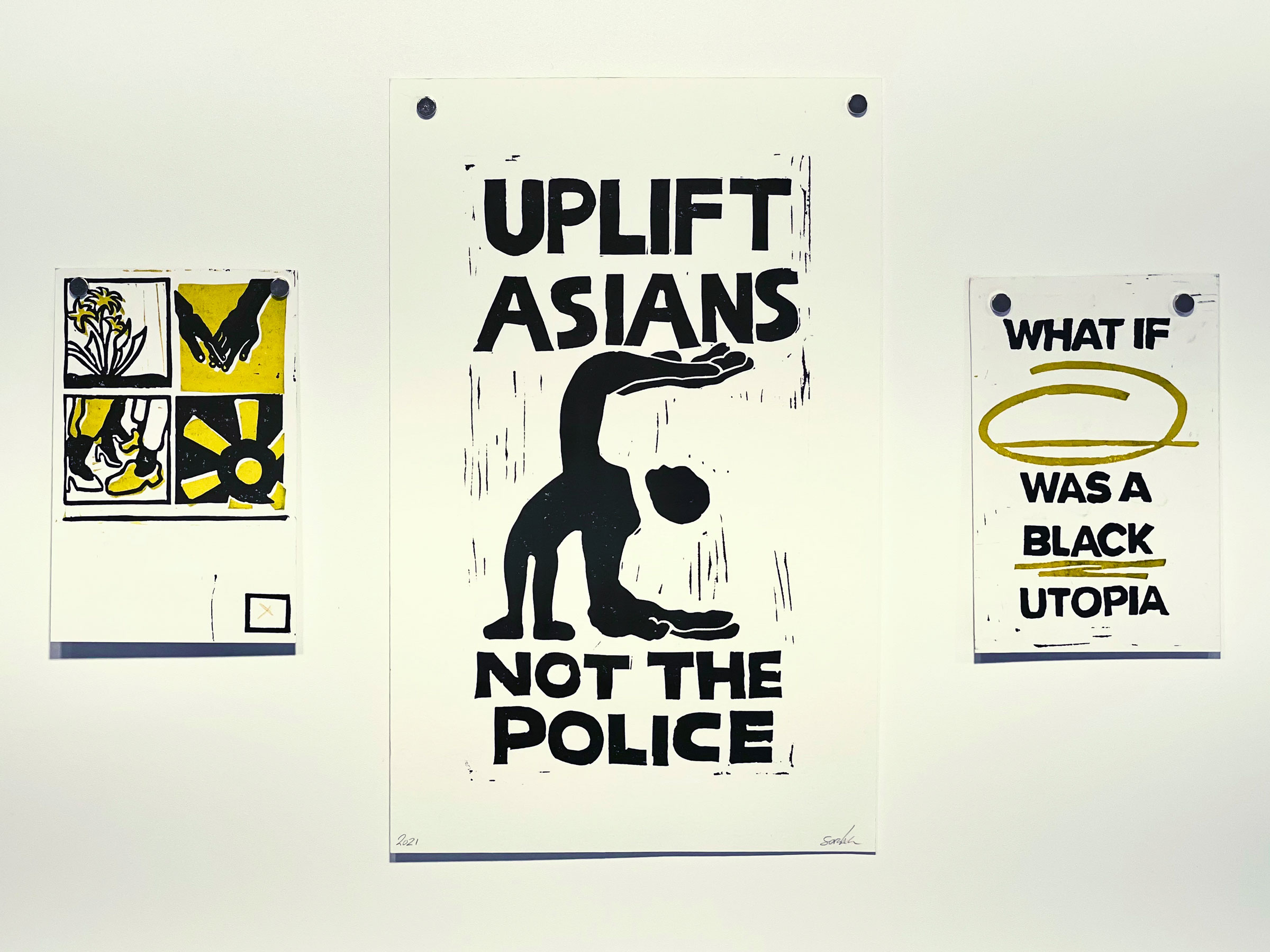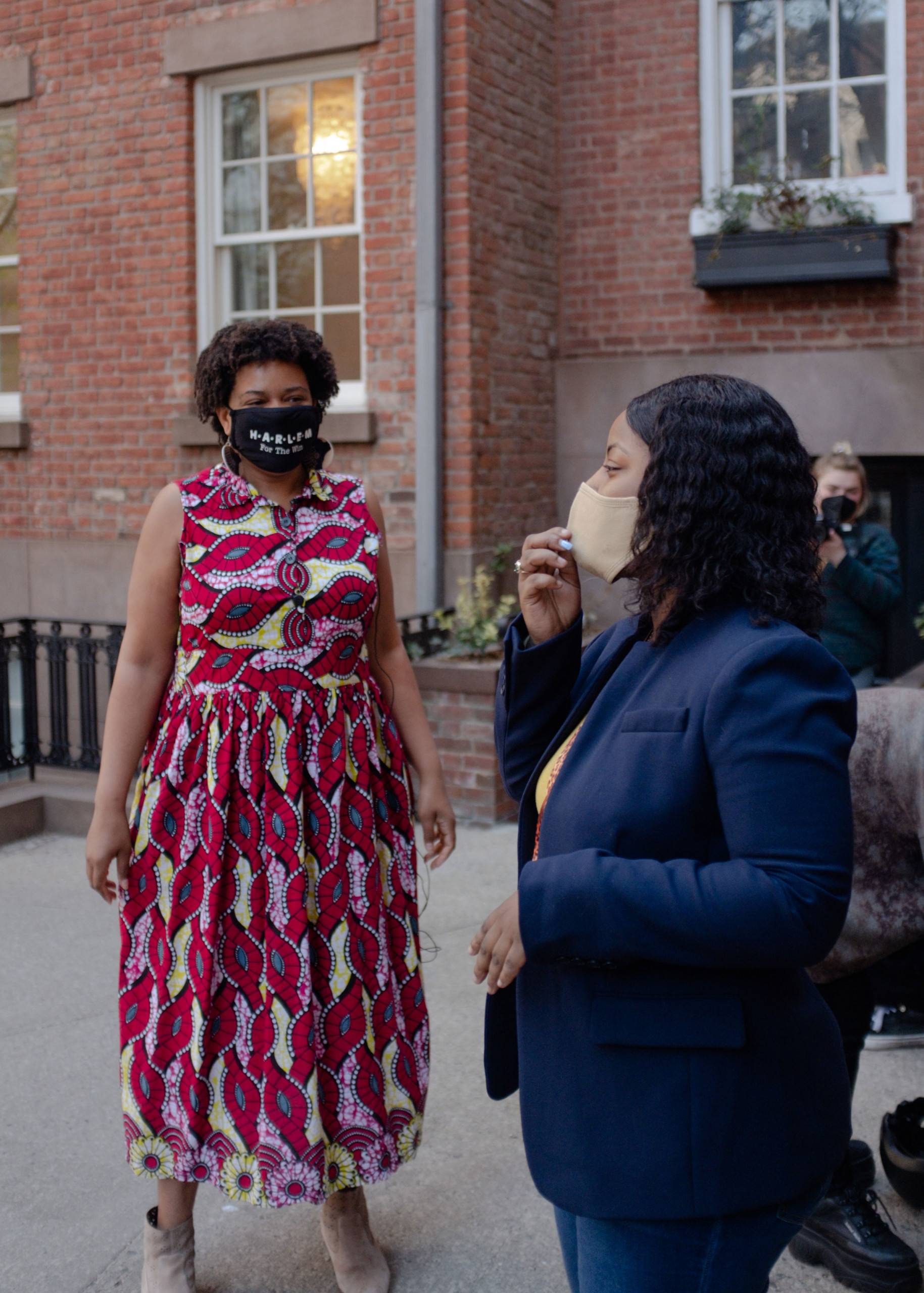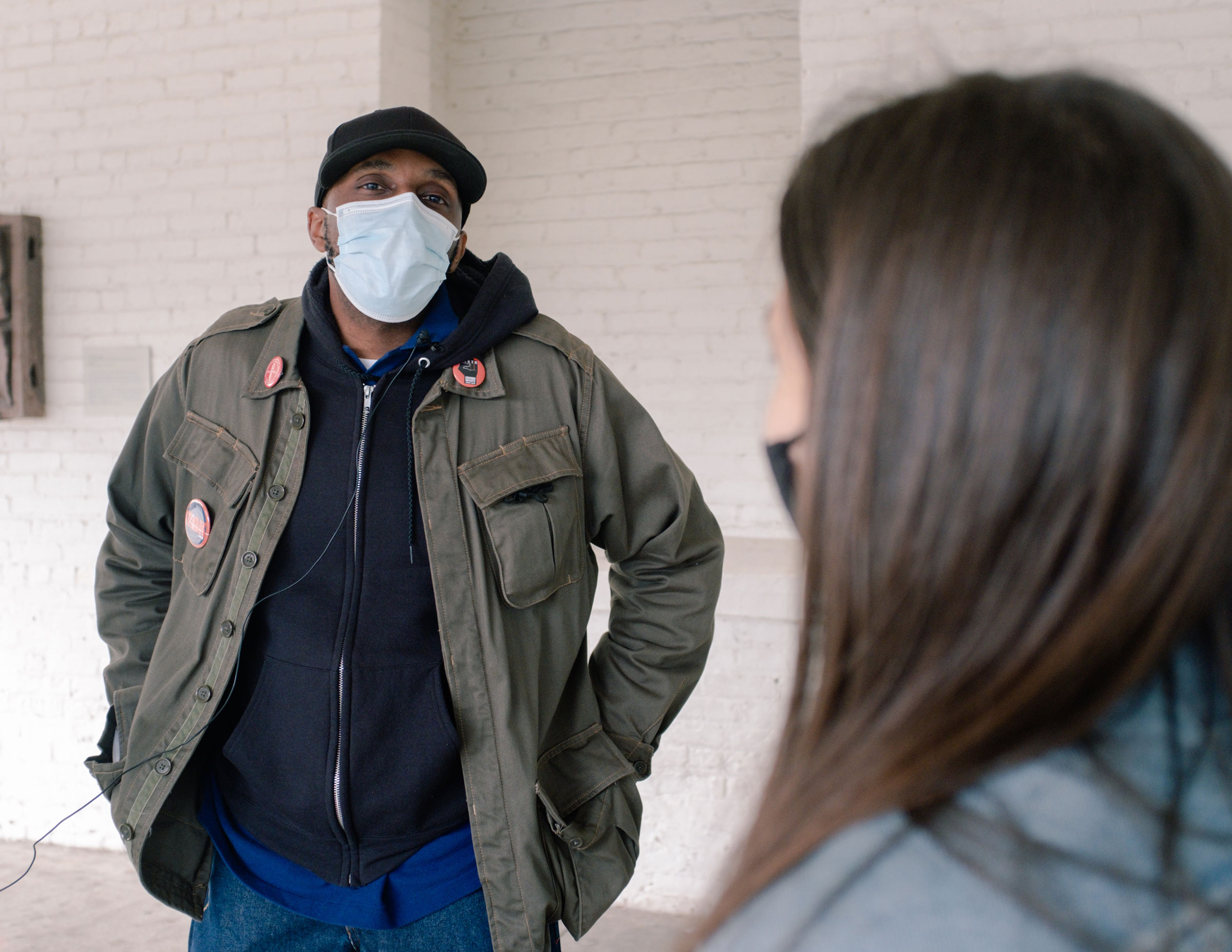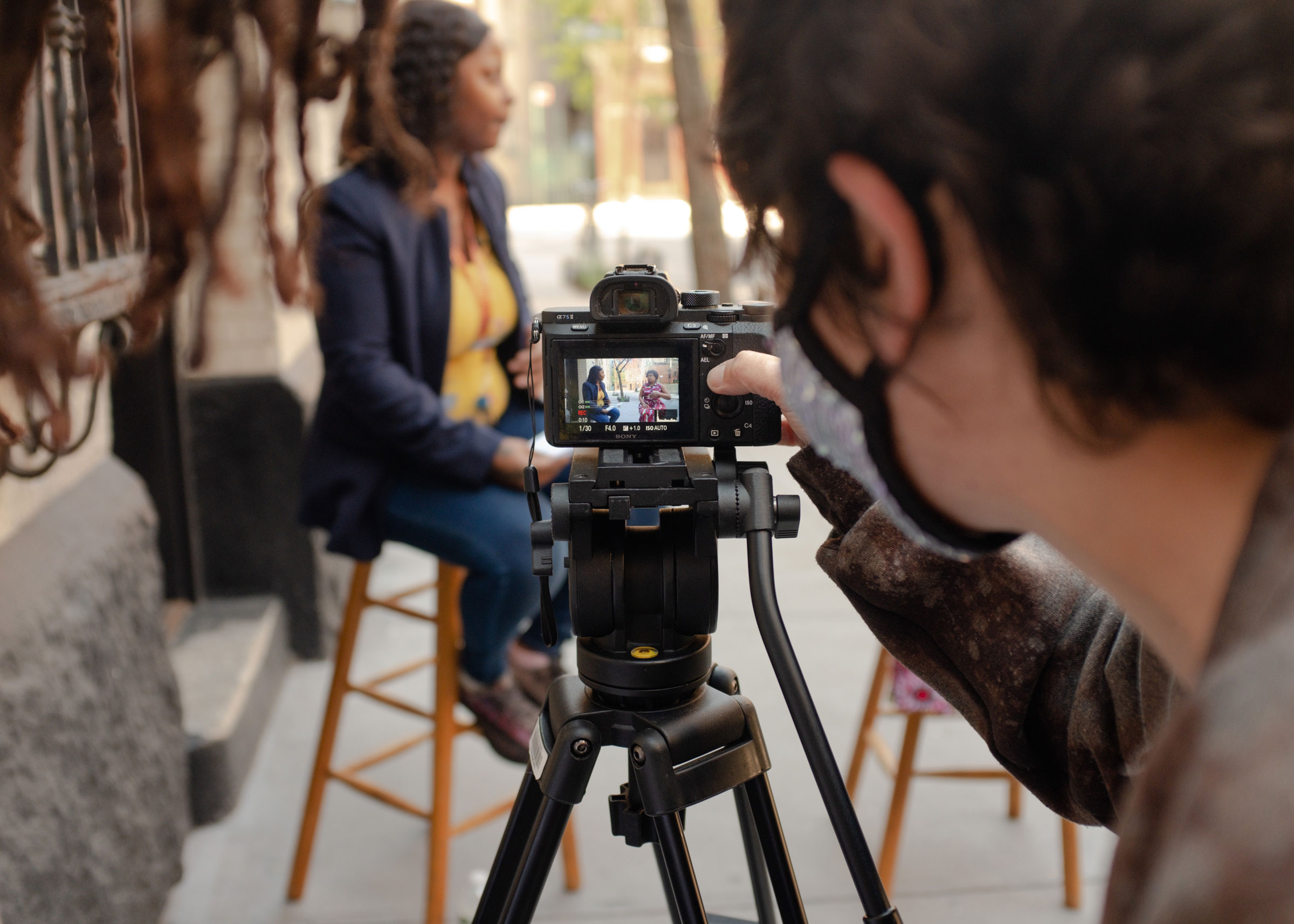As spring unfolded and New York City slowly awakened—ready to reconnect, reimagine, and rebuild life together in the metropolis—students in Pratt Institute’s Fine Arts Social Practice Studio course were imagining how to activate the city, from a political standpoint. Their mission: to humanize politics, specifically at the local level.
On Friday mornings, this group of graduate and undergraduate students from across majors, who dubbed themselves Brooklyn Engaged, logged into a Zoom classroom alongside a group of fellow young people with an interest in arts and activism. They were joining as participants in Recess: Assembly—an artist-led alternative-to-incarceration program, located just a few blocks from the Institute’s campus, that offers long-term, paid training, and pathways to creative employment for court-involved youth.
Led by Pratt’s inaugural Fellow in Civic Engagement, artist Amy Khoshbin, the collaborative team launched a multi-stage project titled Political Intimacy. The Pratt students and Assembly participants, known in their program as Peer Leaders, laid out an intense timeline of activity that would unfold over six weeks. Their plan involved research, brainstorming, generating questions, contacting political campaigns, and producing an eight-minute video interviewing candidates running for the 2021 City Council race in New York City.
Seed paper print by Pratt student Lena Ramsey. Photo by Caroline Cramer, BFA Photography ’22
The Political Intimacy project was rooted in Khoshbin’s own artistic practice, one that merges electoral work with art and creative action in an effort to create policy change. The logistics of making a video for presentation to the public accompanied larger abstract questions: How do we engage young people? How do we build a sense of civic concern? How do we make people care and feel invested in local politics?
One answer to those questions was through mindful, thoughtful social interaction, which Khoshbin modeled, shaped, and facilitated in those Friday morning Zoom sessions, along with Recess: Assembly Artist Fellow Camilo Godoy.
According to Pratt student Alexis Laneuville, BFA Fine Arts (Printmaking) ’21, one of the most memorable aspects of the project was what happened in those gatherings, behind the scenes. “We all connected on a level that maybe some others didn’t think we would be able to,” Laneuville says. “I think that the number one thing for all of us was that we found it in our hearts and our minds to come together for this one very important issue, which was to demystify politics.”
To set the tone for each session, a rhythm of greeting one another, sharing smiles, checking in on both life outside the classroom and the project, framed a sense of camaraderie. These ritualized encounters laid the groundwork for the discussion of deeper, more complex issues, both practical and philosophical — including presentations by each participant on a social issue of concern rooted in their own lived experience.
The use of Zoom breakout rooms also offered a layer of intimacy between participants, fostering interpersonal skills and demystifying perceived differences. For Recess: Assembly peer leader Tyra Gibbs, the experience of both the group and one-on-one chemistry were invaluable. In a breakout room with Pratt student Lena Ramsey, who is majoring in history of art and design with a social practice minor, the two discussed issues such as housing and public transportation and engaged in a mock interview for practice. They also chatted and connected over their pets. For Gibbs, the dynamics of personal encounters with fellow participants and candidates helped to shape a new worldview. “There is a heart in America,” she says. “There is a heart in New York. There’s a heart in your area that is really there for you.”
Seed paper prints by Saint James Forza (left) and Kristina Bivona of Recess. Photos by Caroline Cramer, BFA Photography ’22
For Khoshbin, pedagogical and organizing strategies that focus on building from the ground up, experiential learning, collaborative pedagogy, and non-hierarchical actions are central to her practice. Seminal texts such as bell hooks’s Engaged Pedagogy, Adrienne Maree Brown’s Emergent Strategy, and Pedagogy of the Oppressed by Paulo Freire are works she often returns to for reference. “The sessions were about bringing in your own research on a candidate you’re interested in, bringing that to the group, having a conversation about it, having questions emerge from that process,” says Khoshbin, “and then bringing folks out into the field to understand how to organize and how to produce not only events, but also film shoots, [with the goal of] media literacy.”
Prior to the Political Intimacy project, in the fall of 2020, Khoshbin participated in an electoral working group of Pratt faculty and staff that brainstormed how to motivate people to develop a sustained interest in electoral politics. Of particular interest to her were conversations on how art and activism can blend, and where the line between the two is.
Khoshbin organized several events that addressed that topic, with the support of Assistant Chair of Fine Arts Dina Weiss, as part of Pratt Fine Arts’ Civic Engagement Series. Focused on getting out the vote, events such as Vote, Vote Again: Art in Action, generated new questions from an institutional standpoint that Khoshbin’s Social Practice Studio course specifically engaged. Namely, what does a truly collaborative pedagogy look like?
“How do we bring this [conversation] outside the gates or outside the network of Pratt, into the community in a way that’s more sustainable?” asks Khoshbin. “What we did in the fall were short one-off events because of Zoom. So this [the Social Practice Studio] was a way to be out in the field and bring in Recess, which was amazing.”
In fact, the partnership with Recess builds on relationships formed during the tenure of former Pratt School of Art Visiting Fellow Shaun Leonardo, who brought Pratt students into the fold of his work with Recess: Assembly in 2019. Leonardo also participated in the Political Intimacy project from the vantage point of his recent appointment as a co-director at Recess.
Working in tandem with Jane South, chair of Pratt’s Fine Arts Department, Leonardo was influential in shaping the conversation around civic engagement in Fine Arts during his time at the Institute. Discussions continue around the role of the institution, the power dynamics of institutional hierarchies, and the opportunities in partnerships with organizations like Recess. “I remember Shaun talking about this a lot, the idea of how do you break that methodology?” South says, referring to hierarchical models of learning. “Reciprocity is at the core of it. It is an exchange, it is a sharing, it is acknowledging that everybody has something of value to offer—whether you are the student, the faculty member, the peer leader, the codirector of research. You’re all learning from each other.”
Video created for the Political Intimacy project by Fellow in Civic Engagement Amy Khoshbin, Pratt Institute students, and peer leaders from Recess: Assembly
Reflective of that horizontal approach to learning, participants in the Political Intimacy project also engaged in peer-to-peer learning online, through a seed-paper-making workshop facilitated by Pratt student Lena Ramsey and a printmaking workshop facilitated by Recess: Assembly peer leader Saint James Forza. Both Ramsey and Forza made instructional videos of their own accord to demonstrate the techniques they were teaching.
The printmaking aspect of the project echoed a long history of the use of visual aesthetics in social and political movements, to connect with and unite people through art. Russian constructivists used art as an agent of change, hanging posters in vacant windows to mobilize workers and everyday people to participate in the engineering of a new post-revolutionary society; Taller de Gráfica Popular (TGP, the People’s Print Workshop), founded in 1937 in Mexico, made art accessible and raised political consciousness through prints, posters, pamphlets, and other illustrated publications, addressing cultural identity, politics, Mexico’s indigenous traditions, and the injustices of Spanish colonization; and the Black Panther Party’s Minister of Culture Emory Douglas created posters, pamphlets, and a popular newspaper addressing social justice issues in America, to name a few.

The participants’ seed paper prints were ultimately exhibited at the Pratt Manhattan Gallery, where the final Political Intimacy video premiered and students curated a show of politically relevant work hung alongside their own. The exhibition hung in the gallery’s windows facing out onto 14th Street, and was also part of the thoroughfare’s annual event Art in Odd Places, so anyone passing by could experience the artwork and ideas.
The same critical thinking that informed the 2-D work energized the process of making the video. Conversations on politics and aesthetics shaped the participants’ ideas about how to approach the candidates they interviewed, from City Council candidates Michael Hollingsworth, Kristen Richardson Jordan, Erik Bottcher, and Crystal Hudson to mayoral candidate Paperboy Love Prince.

“When we think of a politician, and when we think of politics, visual representation and aesthetics are the foundation of how a politician is perceived and how politics are understood,” says Recess: Assembly Artist Fellow Camilo Godoy. These considerations prompted the students and peer leaders to think about questions like: Who are the artists making campaign videos or campaign posters or slogans, and what are they trying to communicate? How do we as artists approach artistic and creative decisions? How do we want to frame and record our interviews?
Merging political and aesthetic concerns was one way to empower young people to take their representatives to task, to speak to their motivations and positions, and to humanize them. “They’re just people that want to represent the community. They’re just like you and me,” Khoshbin says.

Pratt undergraduate industrial design major Zichen “Oliver” Yuan, who graduated in May, noted the importance of community at the root of the project. “In the beginning of the Social Practice Studio coursework, we were asked by Amy to take a 15 to 20 minute walk around our neighborhoods without phone, headphones, or anything distracting,” he says. “Observing people, feeling the connection with the community, rewiring with the atmosphere after a whole year of quarantine—this seemed to be the fundamental inspiration for Political Intimacy, a way to intimately interact with a mechanism that has been mystified by traditional politicians and media.”
A Chinese-born international student who has lived in the US for almost eight years, Yuan says that participation in the project opened up his understanding of the local electoral process in America. He describes his in-person interview with artist-activist-mayoral candidate Paperboy Love Prince as something he will never forget. Although Prince’s candidacy was a provocative one rooted in art and a strategic use of spectacle, its support among young people is perhaps a good omen for participatory politics.
“I am excited to see emerging possibilities for politics that make young people like me feel more intimate with the system of power,” says Yuan, and he can draw a straight line between the skills he has honed at Pratt and that kind of engagement. “When I saw the graphics I helped design displayed on 14th Street at Pratt Manhattan Gallery, I felt powerful. I felt the potential for movements and platforms like this.”
Seed paper print by Recess: Assembly peer leader Darrell Santana. Photo by Caroline Cramer, BFA Photography ’22
For Laneuville, who also graduated this spring, the Social Practice Studio course was transformative. “It changed my body of work,” she says. “I think it changed me as a person. I had never had an experience like that before. I come from small-town New York. I had never seen so many beautiful and wonderful people come together for something that’s so important.
This fall she plans to start some social practice work in her hometown, centered on environmental issues. She will be calling on her peers from the class for help.
For Laneuville, Yuan, and their fellow participants, the studio instilled a new level of confidence and empathy grounded in social practice as an approach to art making, and vice versa. Engaging with diverse, intergenerational groups of people from a place of respect, communication, and care, with support from institutions and organizations, these students have borne witness to a potential future activated by mutual concern for our shared humanity.
Reflecting on the semester and the project’s potential growth, Khoshbin says, “It’s rare to find true community care in action. And I feel like this project was working toward that, or rather, is working toward it.”
